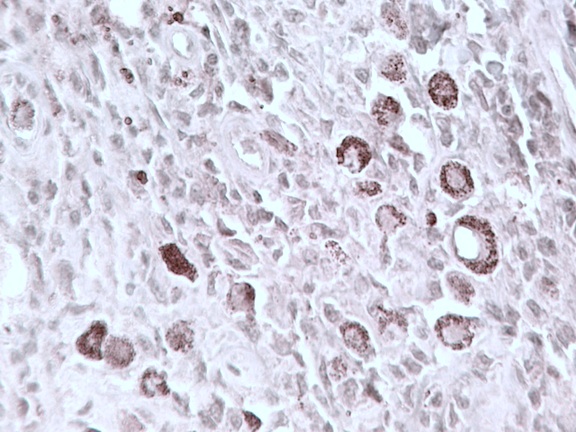Catalogue

Sheep anti Human chx 10 (Visual system homeobox 2) (CT)
Catalog number: X1179P| Isotype | IgG |
| Product Type |
Polyclonal Antibody |
| Units | 250 µg |
| Host | Sheep |
| Species Reactivity |
Chicken Human Mouse Rat |
| Application |
Immunohistochemistry (frozen) Western Blotting |
Background
Chx10 is a 46kDa homeodomain protein of the paired-like class that is essential for development of the mammalian eye. Mutations in Chx10 cause microphthalmia, a cause of congenital blindness in humans, and the ocular retardation (or) phenotype in mice. In the developing mouse retina Chx10 is expressed in retinal progenitors, while in the mature retina, Chx10 expression becomes restricted to bipolar neurons. Concurrent with these expression patterns, the Chx10-/- (or) retina is thin due to a defect in proliferation of retinal progenitors, and lacks bipolar neurons. Chx10 is also expressed in the developing brainstem, thalamus, and spinal cord.
Synonyms: Ceh-10 homeodomain-containing homolog
Product
Antibody raised against a recombinant protein corresponding to amino acids 264 to 361 derived from the C-terminal region of the human Chx10 protein conjugated to KLH.
Product Form: Unconjugated
Formulation: Provided as solution in phosphate buffered saline with 0.08% sodium azide
Purification Method: Ammonium Sulfate Precipitation
Concentration: See vial for concentration
Applications
Detects Chx10 by Western blot at 0.5 to 1 µg/ml. Detects a 46 kDa band in mouse and rat retinal tissue lysates. Optimal concentration should be evaluated by serial dilutions. Suitable for use against recombinant proteins conjugated to OVA, GST, His tags and other.
Functional Analysis: Western Blotting
Positive Control: Rat or mouse retinal tissue lysate.
Storage
Product should be stored at -20°C. Aliquot to avoid freeze/thaw cycles
Product Stability: See expiration date on vial
Shipping Conditions: Ship at ambient temperature, freeze upon arrival
Caution
This product is intended FOR RESEARCH USE ONLY, and FOR TESTS IN VITRO, not for use in diagnostic or therapeutic procedures involving humans or animals. It may contain hazardous ingredients. Please refer to the Safety Data Sheets (SDS) for additional information and proper handling procedures. Dispose product remainders according to local regulations.This datasheet is as accurate as reasonably achievable, but Nordic-MUbio accepts no liability for any inaccuracies or omissions in this information.
References
1. Liu, I.S., et al. Developmental expression of a novel murine homeobox gene (Chx10): evidence for roles in determination of the neuroretina and inner nuclear layer. Neuron 1994, 13, 377-393
2. Chen, C.M. & Cepko, C.L. Expression of Chx10 and Chx10-1 in the developing chicken retina. Mech. Dev. 2000, 90, 293-297
3. Ferda Percin, E., et al. Human microphthalmia associated with mutations in the retinal homeobox gene CHX10. Nat. Genet. 2000, 25, 397-401
4. Nittner, D., et al. Synthetic lethality between Rb, p53 and Dicer or miR-17–92 in retinal progenitors suppresses retinoblastoma formation. Nature Cell Biology (2012), 14, 958-965
5. Kay, J.N., et al. Neurod6 expression defines new retinal amacrine cell subtypes and regulates their fate. Nature Neuroscience (2011), 14, 965-972
6. Eiraku, M., et al. Self-organizing optic-cup morphogenesis in three-dimensional culture. Nature (2011), 472, 51-56
7. Pierfelice, T.J., et al. Notch3 Activation Promotes Invasive Glioma Formation in a Tissue Site-Specific Manner. Cancer Res., 71, 1115-1125 (2011).
PRODUCT SPECIFIC REFERENCES
1. Qiu, F., et al, 'A Comprehensive Negative Regulatory Program Controlled by Brn3b to Ensure Ganglion Cell
Specification from Multipotential Retinal Precursors' Journal of Neuroscience (2008), 28, , 3392-3403
2. Elshatory, Y., et a, 'Islet-1 Controls the Differentiation of Retinal Bipolar and Cholinergic Amacrine Cells' Journal of
Neuroscience (2007), 27, , 12707-12720
3. Osakada, F., et al, 'Wnt Signaling Promotes Regeneration in the Retina of Adult Mammals' Journal of Neuroscience
(2007), 27, , 4210-4219
4. Nittner, D., et al. 'Synthetic lethality between Rb, p53 and Dicer or miR-17–92 in retinal progenitors suppresses
retinoblastoma formation.' Nature Cell Biology (2012), 14, 958–965
5. Tiwari, S., et al. ‘Meckelin 3 Is Necessary for Photoreceptor Outer Segment Development in Rat Meckel Syndrome.’
PLoS One, 8, e59306 (2013)
6. Sherry, D.M., et al. ‘Differential Developmental Deficits in Retinal Function in the Absence of either Protein Tyrosine
Sulfotransferase-1 or -2.’ PLoS One, 7, e39702 (2012)
7. Luo, H., et al. ‘Forkhead box N4 (Foxn4) activates Dll4-Notch signaling to suppress photoreceptor cell fates of early
retinal progenitors.’ Proc. Natl. Acad. Sci. USA, 109, E553-E562 (2012)
8. Haynes, T., et al. ‘Complement anaphylatoxin C3a is a potent inducer of embryonic chick retina regeneration.’ Nat.
Commun. 4, 2312 (2013)
9. Wakabayashi, T., et al. ‘Prolonged Expression of Puma in Cholinergic Amacrine Cells During the Development of Rat
Retina.’ J. Histochem. Cytochem., 60, 777-788 (2012)
10. Bai, L., et al. ‘Birth of Cone Bipolar Cells, but Not Rod Bipolar Cells, Is Associated with Existing RGCs.’ PLoS One, 9,
e83686 (2014)
11. Nakano, T., et al. ‘Self-formation of optic cups and storable stratified neural retina from human ESCs.’ Cell Stem Cell
(2012) 10, 771-785
12. Huang, L., et al. ‘Bhlhb5 is Required for the Subtype Development of Retinal Amacrine and Bipolar Cells in Mice’
Dev. Dyn. (2014), 243, 279-289
Protein Reference(s)
Database Name: SwissProt
Accession Number: P58304
Species Accession: Human
Safety Datasheet(s) for this product:
| NM_Sodium Azide |

|
Immunohistochemical staining of human melanoma tumor tissue using chx10 (CT) antibody (Cat. No. X1179P). Antibody used at ~20 µg/ml. |

Immunohistochemical staining of human melanoma tumor tissue using chx10 (CT) antibody (Cat. No. X1179P). Antibody used at ~20 µg/ml.
